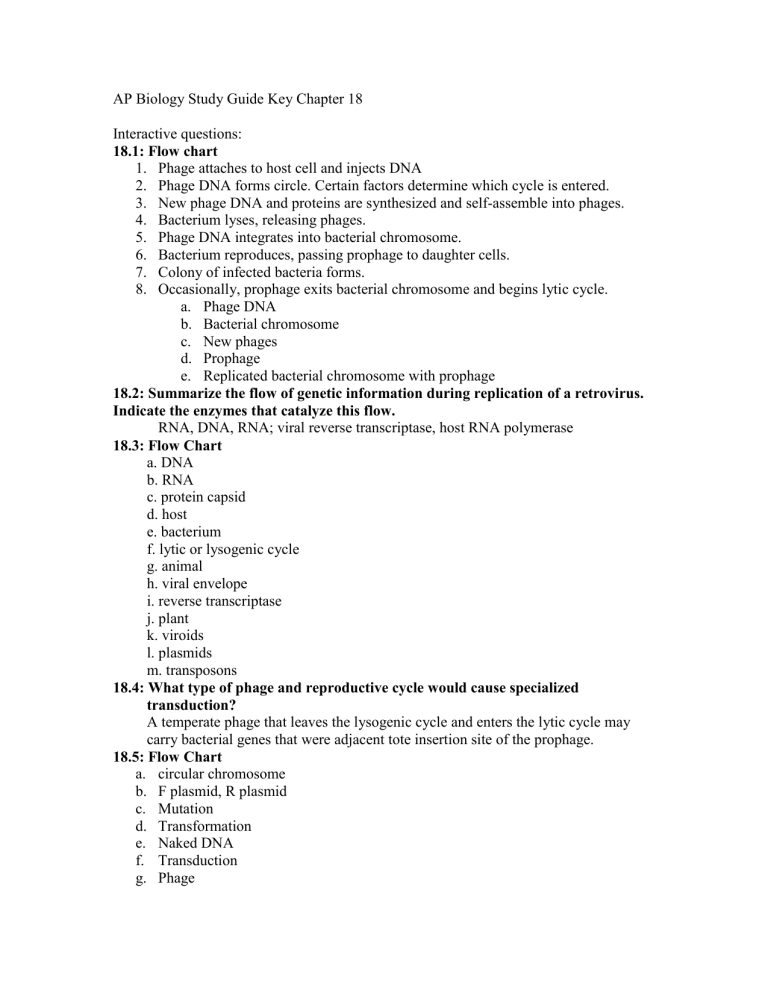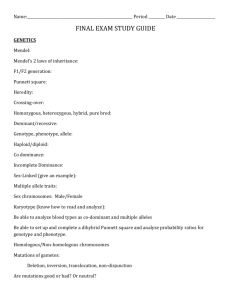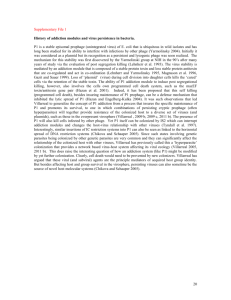AP Biology Study Guide Key Chapter 18

AP Biology Study Guide Key Chapter 18
Interactive questions:
18.1: Flow chart
1.
Phage attaches to host cell and injects DNA
2.
Phage DNA forms circle. Certain factors determine which cycle is entered.
3.
New phage DNA and proteins are synthesized and self-assemble into phages.
4.
Bacterium lyses, releasing phages.
5.
Phage DNA integrates into bacterial chromosome.
6.
Bacterium reproduces, passing prophage to daughter cells.
7.
Colony of infected bacteria forms.
8.
Occasionally, prophage exits bacterial chromosome and begins lytic cycle. a.
Phage DNA b.
Bacterial chromosome c.
New phages d.
Prophage e.
Replicated bacterial chromosome with prophage
18.2: Summarize the flow of genetic information during replication of a retrovirus.
Indicate the enzymes that catalyze this flow.
RNA, DNA, RNA; viral reverse transcriptase, host RNA polymerase
18.3: Flow Chart a. DNA b. RNA c. protein capsid d. host e. bacterium f. lytic or lysogenic cycle g. animal h. viral envelope i. reverse transcriptase j. plant k. viroids l. plasmids m. transposons
18.4: What type of phage and reproductive cycle would cause specialized transduction?
A temperate phage that leaves the lysogenic cycle and enters the lytic cycle may carry bacterial genes that were adjacent tote insertion site of the prophage.
18.5: Flow Chart a.
circular chromosome b.
F plasmid, R plasmid c.
Mutation d.
Transformation e.
Naked DNA f.
Transduction g.
Phage
h.
Conjugation i.
F+ or Hfr and F- cells j.
Transposons k.
Antibiotic resistant genes l.
Adaptation to environment
18.6: Flow Chart a.
regulatory gene b.
promoter c.
operator d.
genes e.
operon f.
RNA polymerase g.
Active repressor h.
Inducer i.
mRNA for enzymes of pathway
18.7: Fill in the Blanks a.
Repressible enzymes usually function in anabolic pathways. The pathway’s product serves as a corepressor to activate the repressor and turn off enzyme synthesis and prevent overproduction of the product of the pathway. Genes for repressible enzymes are usually switched on and the repressor is synthesized in an inactive form. b.
Inducible enzymes usually function in catabolic pathways. Nutrient molecules serve as inducers to stimulate production of the enzymes necessary for their breakdown. Genes for inducible enzymes are usually switched off and the repressor is synthesized in an active form.
Multiple Choice:
1.
The study of genetics of viruses and bacteria has done all of the following except b. illuminate the sexual reproductive cycles of viruses
2.
Beijerinck concluded that the cause of tobacco mosaic disease was not a filterable toxin because d. the infectious agent reproduced and could be passed on from a plant infected with filtered sap
3.
Viral genomes may be any of the following except c. misfolded infectious proteins
4.
Retroviruses have a gene for reverse transcriptase that e. uses viral RNA as a template for DNA synthesis
5.
Virus particles are formed from capsid proteins and nucleic acid molecules a. by spontaneous self-assembly
6.
A virus has a base ratio of (A+G)/(U+C)=1.What type of virus is this? d. a double stranded RNA virus
7.
Vertical transmission of a plant viral disease may involve b. the inheritance of an infection from a parent plant
8.
Bacteria defend against viral infection through the action of b. restriction nucleases that chop up foreign DNA
9.
Drugs that are effective in treating viral infections c. interfere with the synthesis of viral nucleic acid
10.
Which of the following is true of prions? d. They are infectious proteins that may convert brain proteins into misfolded forms.
11.
The herpesvirus a. acts as a provirus when its DNA becomes incorporated into the host cell’s genome
12.
The replication of the genome of an RNA virus uses b. RNA replicating enzymes coded for by viral genes
13.
The replication of the genome of an RNA virus uses a. DNA polymerase from the host
14.
Which of the following would never be an episome? e. all of t above can be episomes
15.
Tiny molecules of naked RNA that may act as infectious agents are c. viroids
16.
When harmless Streptococcus pneumoniae are mixed with heat-killed, broken open cells of pathogenic bacteria, live pneumonia-causing bacteria are found in the culture. d. transformation
17.
Transfer of genes by viruses is called c. transduction
18.
Transfer of antibiotic-resistant genes to R plasmids may occur this way. e. transposon
19.
The source of most of the genetic variation found in bacterial populations is b. mutation
20.
Two mutant E. coli strains, which cannot grow on minimal media, are grown together in complete media (all amino acids supplied). Samples are later transferred to minimal media and numerous colonies are able to grow. a. conjugation or d. transformation
21.
Which of the following is not descriptive of conjugation between an Hfr and F- bacterium? d. Hfr conjugation always transfers antibiotic resistance genes between bacteria.
22.
A regulator gene e. is or does all of the above
23.
Inducible enzymes b. are produced when a small molecule inactivates the repressor protein
24.
In E. coli, tryptophan switches off the trp operon by c. binding to the repressor and increasing the latter’s affinity for the operator
25.
A mutation that renders nonfunctional the product of a regulatory genes for an inducible operon would result in a. continuous transcription of the genes of the operon
26.
An insertion sequence a. carries a gene only for a transposase between two inverted repeats
Matching:
1.
c
2.
d
3.
g
4.
e
5.
f
6.
b
7.
a
8.
h









